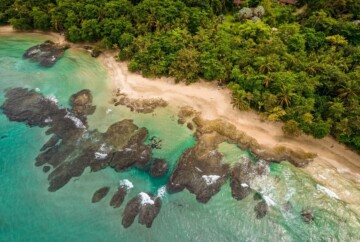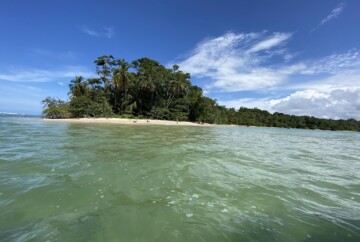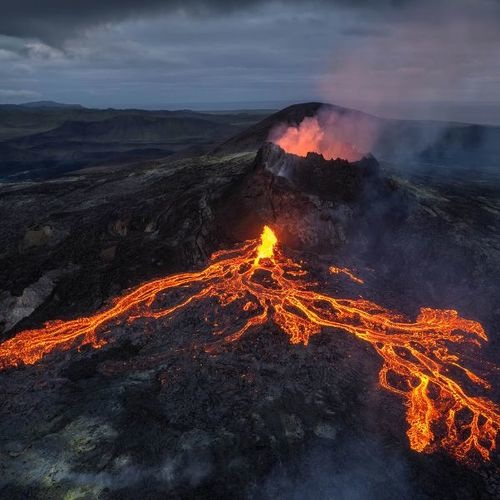Seeing sloths in Costa Rica ended up being one of my absolute favorite parts of our trip. There’s just something about them (maybe their curious nature or unique appearance) that makes it impossible not to feel an instant connection.
Before visiting, I honestly didn’t know much about sloths. That’s why one of the excursions in Costa Rica I was determined to do was a jungle hike with a naturalist guide. I wanted the chance to spot these fascinating creatures up close and learn more about their world.

Where to see sloths in Costa Rica
Sloths can be found in many of the most popular destinations in Costa Rica, especially in tropical rainforests, lush cloud forests, and coastal mangroves. But if you’re hoping for the best odds of seeing them, the Limón province is where they’re most abundant. We took full advantage of our time in Cahuita to join this guided excursion, and I learned so many fascinating facts.
While spotting a sloth on your own isn’t too difficult, getting a close view is another matter entirely. They sleep up to 18 hours a day and often curl up into an almost unnoticeable ball high in the treetops. They can go more than three weeks without coming down to the ground, and because they hardly move, finding them without a trained guide can be a real challenge.
Up next, I’ll share more about the sloths of Costa Rica and how to make your experience unforgettable.
What kind of sloths are there in Costa Rica?
Sloths are one of the most iconic animals in Costa Rica. They’re more than just a tourist favorite; they’re a true symbol of the country’s incredible biodiversity. And once you learn more about them, you’ll see why they stand out so much in the animal kingdom.
For starters, their name is no exaggeration. Sloths spend about 80% of their lives resting, and they can live up to 40 years. They often hang upside down for hours at a time and have a surprisingly flexible neck that can rotate up to 270 degrees, much like an owl.
Their days pass at an unhurried pace. On average, they move only about 6 to 10 feet per minute, and that’s if they’re moving at all. Sometimes they’ll remain in the exact same position for hours, even putting off searching for food. One of the reasons they can be so still is that they carry a tiny ecosystem in their fur; algae and moths live there, and in times when food is scarce, sloths can even feed on the algae growing on their own bodies. They also eat very small amounts, which helps them conserve energy.
There are two different types of sloths in Costa Rica: the two-toed sloth and the three-toed sloth. Each has unique traits that make it relatively easy to tell them apart once you know what to look for.
Two-toed sloths
The two-toed sloth in Costa Rica gets its name from the two long, curved claws on each of its front paws. These strong claws help it cling securely to tree branches, and they’re often paired with a surprisingly effective set of teeth for climbing assistance.
Although both species are famously slow, the two-toed sloth is actually a bit more agile than the three-toed variety. Its muscles are more developed, giving it slightly quicker and more fluid movements. Visually, it also stands out. It has a longer snout, a flatter face, lighter-colored fur, and a stockier build.
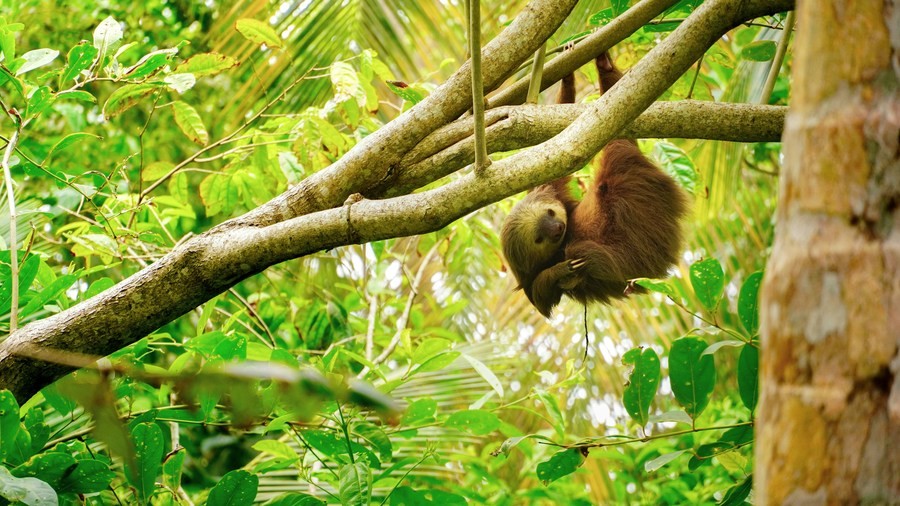
Two-toed sloths
One of its biggest differences, however, is its lifestyle. The two-toed sloth is nocturnal, meaning it’s most active at night. If it decides to descend from its treetop home, it will usually do so under the cover of darkness. This nighttime activity is partly due to its difficulty in regulating body temperature; cooler evening air actually helps it warm itself by moving around.
When it comes to food, the two-toed sloth is a bit of a generalist. Its diet includes leaves, fruits, tender shoots, and even the occasional insect, making it more versatile than its cousin.
Three-toed sloths
As the name suggests, the three-toed sloth in Costa Rica has three claws on each front paw, making it easy to identify at first glance. But beyond that obvious difference, this species has evolved separately from its two-toed relative, leading to distinct differences in behavior, diet, and physical traits.

Three-toed sloths
One of the most charming features of the three-toed sloth is its rounded face, which almost looks like it’s permanently smiling. Unlike the nocturnal two-toed sloth, this species is diurnal, meaning it’s active during the day. Still, “active” is a relative term; it spends most of its daylight hours sleeping or moving at a leisurely pace.
Its diet is much more specialized, consisting almost entirely of leaves. This plant-based menu means it digests food slowly and has very limited energy to spare, so every movement is purposeful. Although it handles cooler temperatures a bit better than the two-toed sloth, both species prefer warm, humid climates that match Costa Rica’s lush habitats.
Best places to see sloths in Costa Rica
If you’re dreaming of spotting sloths in their natural habitat, Costa Rica is one of the best places in the world to do it. The highest concentrations of these adorable, slow-moving creatures are found in the South Caribbean and Central Pacific regions, but I’ll walk you through each destination and share the activities that will give you the best chance of seeing them.
While it’s possible to go sloth-spotting on your own, I have to say, there’s nothing quite like exploring with a professional naturalist guide. These guides are masters at spotting wildlife hidden in the dense greenery, where you or I might only notice a tangle of leaves and branches.
Plus, they enrich the experience with fascinating facts, stories, and insights. You’ll not only have a better chance of seeing sloths, but you’ll also walk away knowing so much more about them and their environment.
Cahuita National Park
Located along Costa Rica’s stunning Caribbean coast, Cahuita National Park is a true natural treasure. This protected area boasts incredible biodiversity, gorgeous stretches of white-sand beach, and the best-preserved coral reef in the entire Caribbean. It’s also right in Limón province, which has the largest concentration of sloths in the country.
One of the most popular activities in Cahuita National Park is hiking the Main Trail, which winds through lush jungle alongside the coastline. We decided to make the most of our visit by booking this private guided tour with a naturalist, and it was the perfect choice.

Cahuita National Park
Along the way, we spotted sloths nestled high in the trees, several different species of Costa Rican monkeys, curious raccoons, and colorful iguanas. The guide’s knowledge brought the entire experience to life, and we learned so much about sloths in particular. And of course, we couldn’t resist taking photos with the sparkling Caribbean Sea as our backdrop.
If you prefer to explore on your own, you can. The 5-mile (about 8-kilometer) trail is flat, easy to follow, and suitable for most travelers. Just note that it’s not a circular route, so it begins at one entrance and ends at another. Many visitors choose to walk to Punta Cahuita (the halfway point) and then return along the same path, which means you won’t see the entire trail.
- Duration: Around 2.5 hours
- Price: From $48
Monteverde Cloud Forest
The Monteverde Cloud Forest is pure magic for hikers, adventure lovers, and wildlife enthusiasts. This is one of the largest cloud forests in Costa Rica, and it’s a fantastic place to spot two-toed sloths. You could easily spend several days exploring here without running out of things to see and do. And if luck is on your side, you might even encounter one of the most celebrated birds in the world: the quetzal, with its dazzling green and red feathers.
The towns of Santa Elena and Monteverde make great bases for your visit, giving you easy access to the Monteverde Cloud Forest Reserve. We chose to join this guided tour, and it was such a rewarding decision. Our guide shared not only the ecological wonders of the forest but also the history of the region.

Monteverde Cloud Forest
When it came to wildlife sightings, we couldn’t have been happier! One of our most memorable sloth encounters in Costa Rica was spotting a three-toed sloth here, even if it was at a distance. We also had close encounters with playful white-faced monkeys, curious coatis, dazzling hummingbirds, and massive blue morpho butterflies fluttering through the misty air.
One thing we didn’t have time for was this night hike, which is one of the most popular tours in Monteverde. Even if you’ve already done a daytime walk, it’s worth coming back after sunset. This is one of the few ways to increase your chances of spotting two-toed sloths, since they’re nocturnal, along with other night-loving creatures like armadillos, spiders, reptiles, amphibians, and countless insects. In fact, around 80 percent of the forest’s wildlife is most active after dark, so the odds of sightings are even better.
- Duration: 2 to 2.5 hours
- Price: From $30
Gandoca-Manzanillo Wildlife Refuge
Down on the far southeastern tip of Costa Rica’s Caribbean coast lies the Gandoca–Manzanillo Wildlife Refuge, a protected natural wonder where lush rainforest meets pristine beaches. It’s one of the top places to see sloths in the wild, and the best part is that entry is completely free. If you’re traveling on a budget but still want that “wild Costa Rica” experience, this is a destination you should definitely consider.
What makes Gandoca–Manzanillo so special is its mix of ecosystems: tropical rainforest, wetlands, and mangroves, which together support an incredibly diverse array of wildlife. We joined this guided tour here, and it didn’t disappoint. We saw several sloths lounging lazily in the trees, as well as vibrant toucans, playful parrots, colorful frogs, and even some Costa Rican sea turtles.
If you visit between March and June, you’re in for an extra treat: the leatherback turtle nesting season.

Gandoca-Manzanillo Wildlife Refuge
Once your guided hike is done, I recommend spending extra time exploring on your own. Stay at the lookout point at the end of Playa Manzanillo for sweeping coastal views, or simply relax on the beach and do some snorkeling in the clear Caribbean waters.
Getting here is easy: you can base yourself in Puerto Viejo, a vibrant beach town filled with great restaurants, cafés, and accommodation options. Or, for a quieter experience, head directly to Manzanillo. It’s much smaller and more laid-back, but keep in mind there are fewer services.
- Duration:5 hours
- Price: From $58
Tortuguero National Park
Tortuguero National Park is a protected paradise unlike anywhere else I’ve visited. Honestly, I think it’s one of the best national parks in Costa Rica, as it feels like stepping straight into a nature documentary. The most popular way to discover it is by taking a tour of its canals.
The canal tour can be done year-round, which makes it a great option no matter when you visit. You have a few choices when it comes to boats, but we went for this canoe tour, and I’m so glad we did. The smaller, quieter boat meant fewer people in the group and a better chance of spotting wildlife. For those who want to paddle themselves, kayak tours are also available, but in every case, you’ll need to join a guided group, as boating independently through the canals isn’t allowed.

Tortuguero National Park
We spent about three hours gliding through calm waters, and along the way, we spotted alligators, snakes, monkeys, and countless species of birds. Sadly, the sloths were hiding from us that day, although some friends we met later told us they’d seen them just the day before. That’s part of the beauty of Tortuguero: every tour is different, and you never know what you’ll encounter. Regardless of the sightings, the feeling of being immersed deep in the jungle is simply unforgettable.
If you’d like to increase your chances of seeing sloths here, another fantastic option is this guided hike along the Jaguar Trail, one of the most popular activities in Tortuguero. This circular trail is about 5 miles long and offers the opportunity to spot sloths, monkeys, toucans, reptiles, amphibians, and a huge variety of birds. Sightings of jaguars themselves are extremely rare, but it’s worth noting that this national park has one of the largest jaguar populations in Costa Rica, and occasionally, they even wander down to the beach at night in search of nesting turtles.
- Duration: 3 hours
- Price: from $28
Manuel Antonio National Park
Manuel Antonio National Park is one of the most visited spots on Costa Rica’s Pacific coast, and it doesn’t take long to see why. Yes, it can get busier here than in other areas of the country, but the combination of lush rainforest, sparkling beaches, and rich wildlife makes it a place you can’t skip. It’s also one of the top places to see sloths, so exploring its trails is always a rewarding experience.
There are plenty of tours in Manuel Antonio, which can make deciding a bit tricky. We chose this guided tour so we could enjoy the scenery while benefiting from an expert’s trained eye. In hindsight, it was the best choice we could have made. Without a guide, we probably would have walked right past half the animals we saw, as the dense vegetation hides them well.

Manuel Antonio National Park
If you prefer to explore on your own, that’s totally fine too. The park has a well-marked network of 10 interconnected trails, so you can wander at your own pace and chart your own route. You can check out our guide on Manuel Antonio National Park for all the details.
Beyond the forest and jungle, there’s also a third fascinating ecosystem here: the mangrove swamp. One of the best ways to experience it is on this boat tour to Damas Island. As you navigate the estuary, you might spot sloths, as well as a variety of other fascinating creatures.
And if you’re feeling adventurous, consider adding this night tour to your itinerary. When the sun sets, the park transforms completely. Many animals emerge in search of food, while others hide from nocturnal predators, and you can just enjoy a thrilling sloth excursion in Costa Rica.
- Duration: 3 hours
- Price: from $27
University of Costa Rica at San José
If you’re exploring the attractions of San José and want to connect with nature, you might be surprised to learn that you can spot sloths right in the heart of the city. The University of Costa Rica campus is home to one of the largest forested areas in the capital, and you can join this guided tour led by a biologist, which lasts about two and a half hours.
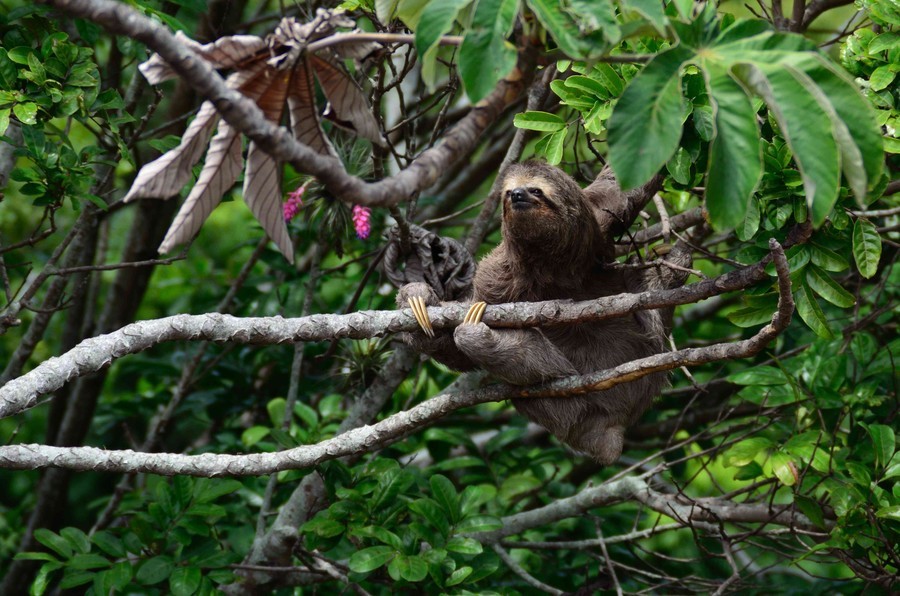
University of Costa Rica at San José
During our visit, we wandered shaded trails while listening to fascinating explanations from young university students, professional biologists, and other experts. The highlight of our sloth adventure in Costa Rica was watching these gentle creatures climb effortlessly through the treetops, completely at home in their natural habitat. We also saw colorful native Costa Rican birds, delicate butterflies, and a variety of insects, all while learning about the country’s unique ecosystems, history, and culture.
One of the things I loved most about this tour is that part of the proceeds go toward funding conservation and education projects, helping ensure that these kinds of experiences can continue for future visitors. So, if you’re passionate about responsible tourism, this is a wonderful activity to add to your list.
- Duration: 2.5 hours
- Price: from $35
Best sloth tours in Costa Rica
Here’s a handy overview of the top sloth tours in Costa Rica, making it easy for you to compare your options and pick the one that perfectly fits your travel style.
TOUR | PRICE | DURATION | SLOTH SPECIES | HIGHLIGHTS |
|---|---|---|---|---|
$48 | 2.5 hours | Three-toed sloths | • Cahuita National Park tour |
|
$30 | 2.5 hours | Three-toed sloths | • Monteverde Cloud Forest tour |
|
$27 | 2 hours | Two-toed sloths | • Night tour in Monteverde Cloud Forest |
|
$58 | 2.5 hours | Three-toed sloths | • Gandoca-Manzanillo Wildlife Refuge tour |
|
$28 | 3 hours | Three-toed sloths | • Canoe tour through Tortuguero Canals |
|
$40 | 2.5 hours | Three-toed sloths | • Kayaking in Tortuguero |
|
$27 | 3 hours | Three-toed sloths | • Manuel Antonio National Park tour |
|
$75 | 4 hours | Three-toed sloths | • Boat tour through Damas Island mangroves |
|
$39 | 2 hours | Two-toed sloths | • Guided night walk through Manuel Antonio |
|
$35 | 2.5 hours | Two- and three-toed sloths | • Guided walk through the University of Costa Rica |
|
BEST SLOTH TOURS IN COSTA RICA |
||||
Best sloth sanctuaries in Costa Rica
Deforestation, the spread of cities into once-remote rural areas, and even illegal hunting are sadly some of the biggest threats facing Costa Rica’s beloved sloths.
When we passed through Puerto Viejo, we actually came across a sloth making its slow way across the road. A friendly shopkeeper nearby told us this happens more often than visitors imagine, and that sometimes sloths, confused by human-made landscapes, mistake electric poles for trees, which can lead to tragic accidents like electrocution. Hearing that made me realize just how important the country’s network of animal refuges really is.
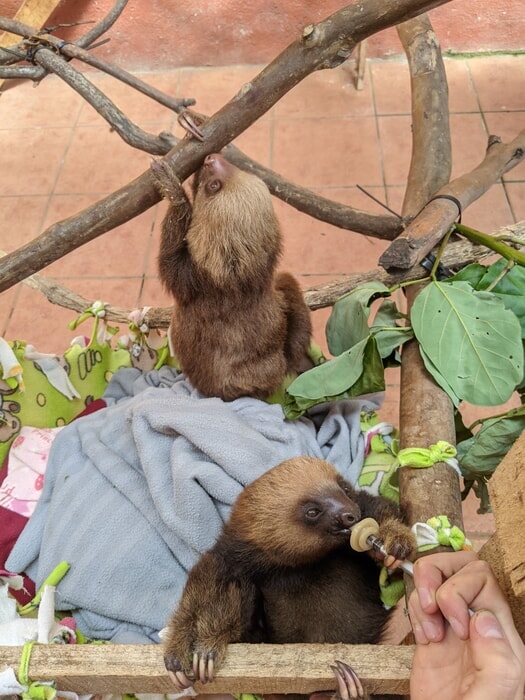
Best sloth sanctuaries in Costa Rica
That’s where Costa Rica’s wildlife sanctuaries come in. They provide shelter and care for orphans, treat injured animals, and rehabilitate those that have been displaced, always with the hope of returning them to the wild. Even for the animals that cannot be released, sanctuaries ensure they can live safely, with proper nutrition and a naturalistic environment.
Visiting one of these places isn’t just an amazing travel experience; it’s also a way to directly contribute to sloth conservation efforts in Costa Rica, since your entry fee helps fund food, medicine, and the daily work of dedicated staff and volunteers.
Here are some of the most notable sloth sanctuaries in Costa Rica:
- Sloth Sanctuary in Costa Rica: Spread across 790 acres of forest, this sanctuary is home to more than 200 rescued sloths. Guided tours (both group and private) take you behind the scenes of their rescue, rehabilitation, and release programs, offering a closer look at the sanctuary’s mission.
- Hours: Daily, 8 am–4 pm
- Location: Route 36, 18.6 miles south of Limón, Limón Province, 7302
- Costa Rica Animal Rescue Center: This center helps both wild and domestic animals that have suffered abuse or injury. Many residents were rescued from illegal trafficking or the tourism trade. A small staff works alongside dedicated volunteers, and guided tours give you a chance to see the animals and hear their stories.
- Hours: Daily, 9 am–2 pm
- Location: Juntas, Alajuela Province, Turrúcares
- Costa Rica Animal Shelter: Receiving around 1,500 animals every year, this shelter plays a major role in the country’s wildlife rehabilitation network. Their goal is to release at least 70% of these animals back into the wild, though some remain permanently under their care if reintroduction isn’t possible. Visitors can join guided tours or even apply to volunteer.
- Hours: Daily, 9 am–4:30 pm
- Location: San José, Santa Ana, 10094, Costa Rica
- Alturas Wildlife Sanctuary: Located near Dominical Beach, this center offers a fully equipped clinic and two specialist veterinarians. Injured, orphaned, or abandoned animals receive top-notch care before returning to the wild when possible. You can join one of their three daily guided tours or volunteer for hands-on work.
- Hours: Tuesday–Sunday, 9 am–3 pm
- Location: San Martin Nte Street, Puntarenas Province, Dominical Beach, Costa Rica
- Toucan Rescue Ranch (TRR): Originally created to rescue and rehabilitate toucans, TRR has since opened its doors to many other species, including sloths. Here, animals receive medical treatment and expert care from an international team of veterinarians, biologists, and researchers. The sanctuary also runs educational programs and offers internships in zoology, biology, and veterinary medicine. After a guided tour, you can relax at their on-site café, sipping Costa Rican coffee while watching sloths lounge in the treetops.
- Location: 5 miles east, 0.25 miles north, off Route 112 near downtown San Josecito, Heredia, San Isidro, Costa Rica
That’s a wrap on Costa Rica’s sloths! If you’ve visited any of these sanctuaries or joined one of the tours I mentioned earlier, I’d love to hear about your experience. Drop a comment below so other travelers can benefit from your tips. And of course, if you have questions, I’m here to help.
Pura Vida!















